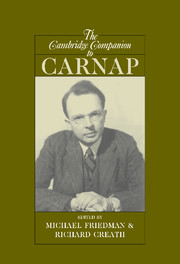Book contents
- Frontmatter
- Introduction: Carnap’s revolution in philosophy
- 1 Carnap’s intellectual development
- 2 Geometrical leitmotifs in Carnap’s early philosophy
- 3 Carnap and Frege
- 4 Carnap and Husserl
- 5 Carnap, Russell, and the external world
- 6 The Aufbau and the rejection of metaphysics
- 7 Carnap and the Vienna Circle: rational reconstructionism refined
- 8 Carnap and modern logic
- 9 Tolerance and logicism: logical syntax and the philosophy of mathematics
- 10 Carnap’s quest for analyticity: the Studies in Semantics
- 11 Carnap on the rational reconstruction of scientific theories
- 12 Carnap on probability and induction
- 13 Carnapian pragmatism
- 14 Quine’s challenge to Carnap
- Bibliography
- Index
11 - Carnap on the rational reconstruction of scientific theories
Published online by Cambridge University Press: 28 April 2008
- Frontmatter
- Introduction: Carnap’s revolution in philosophy
- 1 Carnap’s intellectual development
- 2 Geometrical leitmotifs in Carnap’s early philosophy
- 3 Carnap and Frege
- 4 Carnap and Husserl
- 5 Carnap, Russell, and the external world
- 6 The Aufbau and the rejection of metaphysics
- 7 Carnap and the Vienna Circle: rational reconstructionism refined
- 8 Carnap and modern logic
- 9 Tolerance and logicism: logical syntax and the philosophy of mathematics
- 10 Carnap’s quest for analyticity: the Studies in Semantics
- 11 Carnap on the rational reconstruction of scientific theories
- 12 Carnap on probability and induction
- 13 Carnapian pragmatism
- 14 Quine’s challenge to Carnap
- Bibliography
- Index
Summary
INTRODUCTION
Carnap's intellectual development is documented in his “Intellectual Autobiography” (Carnap, 1963a). For present purposes it is worth recalling that he studied with Frege at Jena in the years 1910-14, taking two courses on Frege's conceptual notation or Begriffsschrift and the course “Logic in Mathematics.” His early relationship to Russell also merits mention. Shortly after the First World War, Carnap wrote to Russell asking where he might purchase a second-hand copy of Principia Mathematica; Russell responded by copying out by hand 35 pages of its central definitions. From the intellectual autobiography we also learn that Carnap's interest in philosophy of physics emerged early in his career. As a doctoral student, he formulated the intention of writing a dissertation on the axiomatization of special relativity. The less than enthusiastic reception of this idea by Max Wien, the head of the Institute of Physics at Jena, led him to write on the foundations of geometry instead. The dissertation was completed in 1921 under the title “Der Raum,” and it shows the central influence of Hilbert.
- Type
- Chapter
- Information
- The Cambridge Companion to Carnap , pp. 248 - 272Publisher: Cambridge University PressPrint publication year: 2007
- 14
- Cited by

